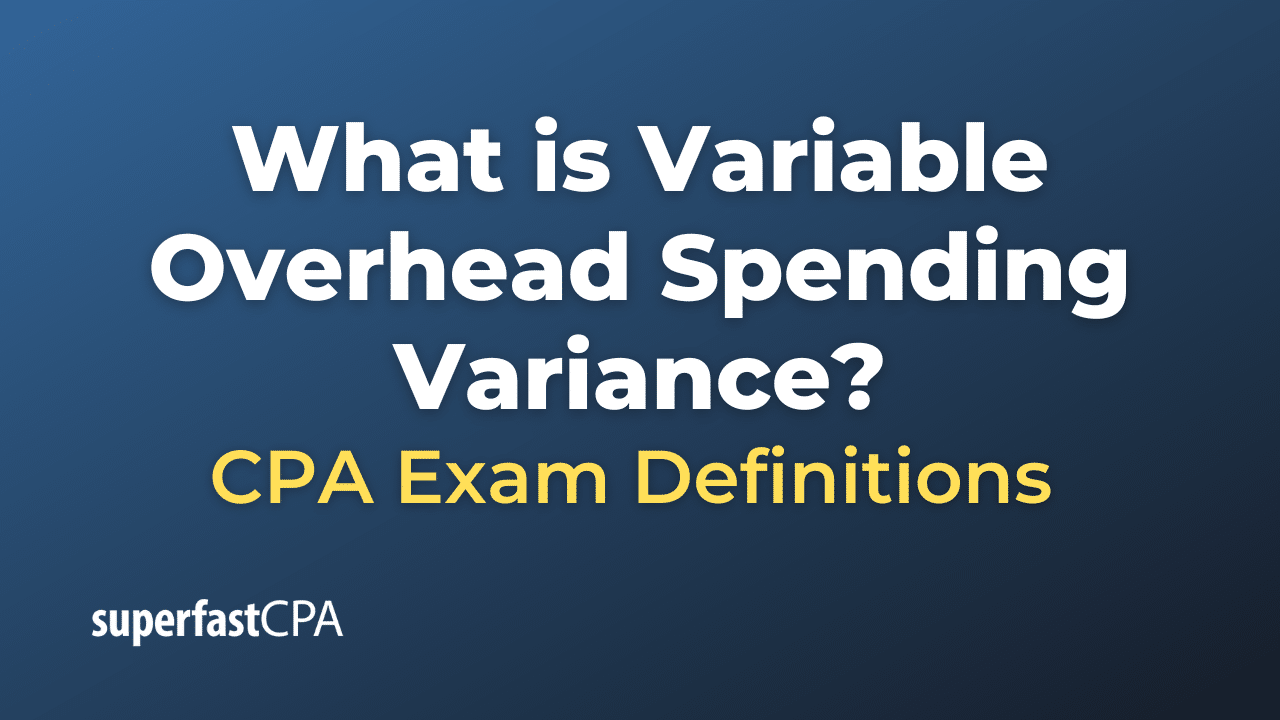
If the standard variable overhead rate is higher than the actual variable overhead rate, the result is favorable variable overhead spending variance. On the other hand, if the actual variable overhead rate is higher, the variance is unfavorable. This means that the actual variable overhead cost during the period is higher than the overhead cost that is applied to the actual hours worked using the standard variable overhead rate. Variable production overheads by their nature include costs that cannot be directly attributed to a specific unit of output unlike direct material and direct labor which vary directly with output. Traditional management accounting often define blanket variables such as machine hours or labor hours which seldom provides a meaningful basis of cost control.

What are the formulas to calculate the overhead variances?
Budget or spending variance is the difference between the budget and the actual cost for the actual hours of operation. This variance can be compared to the price and quantity variance developed for direct materials and direct labor. In conclusion, the variable overhead variance is an important tool for measuring and controlling indirect costs, and is used to evaluate the efficiency of overhead spending. Consequently by analyzing the variance, management can identify areas for improvement and take steps to reduce the cost of variable overhead, thereby increasing profitability and competitiveness. Optimize your financial performance by understanding and managing variable overhead spending variance with strategic insights and practical solutions. Using the information given below, compute the fixed overhead cost, expenditure, and volume variances.
Variable Overhead Variance
Specifically, fixed overhead variance is defined as the difference between Standard Cost and fixed overhead allowed for the actual output achieved and the actual fixed overhead cost incurred. In this example, the variable overhead rate variance is positive (50 favorable), and the variable overhead efficiency variance is also positive (100 favorable), resulting in an overall positive variable overhead variance (150 favorable). When delving into the causes of variable overhead spending variance, it is important to consider the role of unexpected changes in production volume. Fluctuations in production can lead to deviations in costs, especially if the volume exceeds or falls short of projections.
- Adam received his master’s in economics from The New School for Social Research and his Ph.D. from the University of Wisconsin-Madison in sociology.
- Additionally the method of allocation is more fully discussed in our applied overhead tutorial.
- Variable Overhead Spending Variance is essentially the difference between what the variable production overheads actually cost and what they should have cost given the level of activity during a period.
- These costs are not directly tied to the production of a specific unit but are necessary for the overall manufacturing process.
- The other variance computes whether or not actual production was above or below the expected production level.
- Regularly updating forecasts to reflect current market conditions and production changes can help companies stay agile and responsive to unforeseen challenges.
Understanding Variable Overhead Spending Variance
Variable production overheads include costs that cannot be directly attributed to a specific unit of output. Costs such as direct material and direct labor, on the other hand, vary directly with each unit of output. Total overhead cost variance can be subdivided into budget or spending variance and efficiency variance. This type of variance is calculated separately for direct variable expenses and overhead variable expenses. In the standard costing system, the variable overhead is posted at the standard cost of 1,250 represented by the debit to the work in process inventory account. Accurate budgeting and forecasting are fundamental strategies for managing variances.
Sometimes these flexible budget figures and overhead rates differ from the actual results, which produces a variance. This example provides an opportunity to practice calculating the overhead variances that have been analyzed up to this point. The negative ninety represents that 4ever Manufacturing had to pay $9,000 more than expected to spend on variable overheads.
Overhead Variances
Fixed overhead budget variance is one of the two main components of total fixed overhead variance, the other being fixed overhead volume variance. Variable overheads are those costs which vary in response to the level of production output but which cannot be attributed to individual units of production. For example, an item might be manufactured by equipment which cuts and shapes a sheet of plastic. Effectively managing variable overhead spending variance requires a comprehensive approach that integrates proactive planning, vigilant monitoring, and strategic adjustments. By addressing potential variances before they manifest, companies can maintain financial stability and improve their operational efficiency.
Variable overhead spending variance is essentially the difference between the actual cost of variable production overheads versus what they should have cost given the output during a period. Controlling overhead costs is more difficult and complex than controlling direct materials and direct labor costs. However at the end of 2019 due to an incorrect estimation of overheads the actual instructions 2020 variable overhead per hour rate was $15 and the actual hours worked were 4,500. The quantity and price of indirect materials and labor, utility bills, quality control, and others are forecasted based on expected demand. (c) In addition, prepare a reconciliation statement for the standard fixed expenses worked out at a standard fixed overhead rate and actual fixed overhead.
Overheadsare production expenditures that are indirect i.e. can’t be traced back to oneunit of production like direct material or direct labor. This is a portion of volume variance that arises due to high or low working capacity. It is influenced by idle time, machine breakdown, power failure, strikes or lockouts, or shortages of materials and labor.
The $1,400 of unfavorable variable overhead spending variance can be used with the variable overhead efficiency variance to determine the total variable overhead variance. This is due to the total variable overhead variance equal the variable overhead spending variance plus the variable overhead efficiency variance. On the other hand, the standard variable overhead rate can be determined with the budgeted variable overhead cost dividing by the level of activity required for the particular level of production. Standard variable overhead rate may be expressed in terms of the number of machine hours or labor hours. Very often however, companies have a combination of manual and automated business processes which may necessitate the use of both basis of variable overhead absorption. Figure 8.5 shows the connection between the variable overhead rate variance and variable overhead efficiency variance to total variable overhead cost variance.
This formula takes the difference between the standard quantity and the actual quantity of variable overhead allocated, and multiplies this by the standard variable overhead rate. It is useful to note that the variable overhead spending variance is also known as the variable overhead rate variance. This name properly makes it easier to understand that the concept of this variance is about the difference between the standard variable overhead rate and the actual variable overhead rate. Alternatively, the variable overhead spending variable formula can also be written as the standard variable overhead rate multiplying with actual hours worked and then using the result to deduct the actual variable overhead cost.
The fixed overhead spending variance is the difference between the actual fixed overhead expense incurred and the budgeted fixed overhead expense. An unfavorable variance means that actual fixed overhead expenses were greater than anticipated. This is one of the better cost accounting variances for management to review, since it highlights changes in costs that were not expected to change when the fixed cost budget was formulated.
